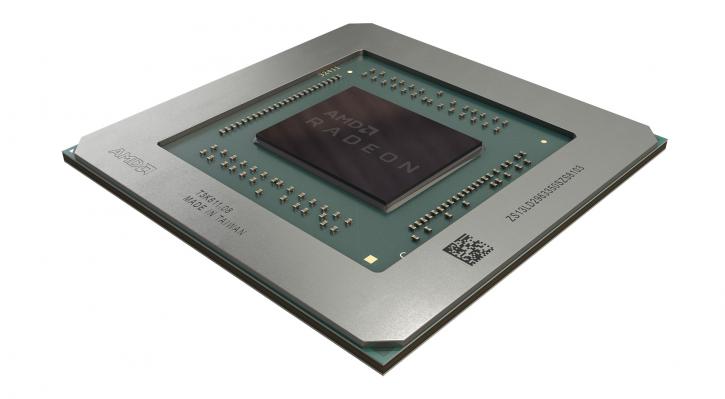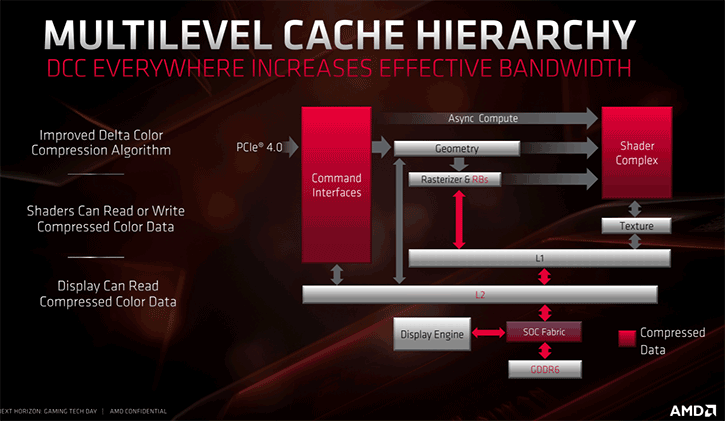A bit of Architecture
Radeon 5700 and 5700 XT
During the keynote speech AMD announced and named the 7nm NAVI based graphics cards the Radeon RX 5000 series products. AMD considers Navi to be a completely new architecture. No longer GCN, but RDNA (Radeon DNA). RDNA uses redesigned Compute Units, which should significantly increase per-clock performance and efficiency. This also includes a new cache structure. The changes are expected to boost performance by at least 25 percent per cycle ("IPC") seen from Vega and increase efficiency (wattage) by at least 50 percent.
Raytracing?
Nope. Ever since the beginning, Raytracing was never mentioned in any presentation, the Navi cards do not have native hardware support for it, despite what the competition is doing. Weirdly enough we think (currently) that is an advantage for AMD, as they can fab smaller and less expensive silicon, making the product more affordable as to what NVIDIA is offering with the GeForce RTX series. AMD, however, has hinted that the NAVI GPUS to follow NAVI10 (Big Navi) will get some sort of hardware accelerated Raytracing functionality. But the general consensus is simple, the time is not right to go full on Raytracing and this AMD sticks to an evolved Shader engine.
NAVI 10 - 10.3 billion transistors, 251mm2 die size
According to AMD, the Navi architecture will serve as the foundation for video cards for gamers in the coming years. Navi will be born and named as Radeon RX 5700 series, with the Radeon RX 5700 and 5700 XT series released initially. The NAVI architecture also will make its way into the Next-gen PlayStation, based on Zen2 and NAVI. NAVI is based on 7nm RDNA architecture (Radeon DNA).
No GCN, but RDNA (a new more efficient shader architecture)
Going back to RDNA then. AMD emphasizes strongly that RDNA is a new architecture, for which the chip designer makes the comparison between Zen and Bulldozer. The reality is that NAVI in its current we would say the architecture is new, but and shares minor design elements of GCN, the compute units have been completely overhauled though and we indeed agree and say, this is a new architecture.
AMD mentions that RDNA has been specially developed for gamers. AMD RDNA would offer 25% better performance per clock, and 50% better performance per watt. The strong focus overall was to increase IPC and then in specific on a single thread.
That last bit (more energy efficient and a smaller design allows more transistors) also leans on the fact that they came from 12/14nm moving towards 7nm. RDNA would see a more 'pure' appearance in Navi 20. As mentioned before, ‘Big Navi’, a chip that will not likely be on the market until next year.
The key point for this release I need to bullit up as there was not enough time to go really deep with this article (we received all our info hours before launch):
- New Multilevel cache hierarchy offers improved cache efficiency (added new L1 cache (128kb), doubled load bandwidth LO to ALU
- Optimized pipeline increases IPC
- Compared to the last-gen rDNA should yield more than 50% extra performance per watt relative to GCN.
- Compared to Vega 64 this NAVI10 is offering 14% more performance while using 23% less power.
- Raytracing vision from AMD is simple, they believe Raytracing will evolve from shader based towards hardware accelerated raytracing at the right time. Next-gen NAVI should support hardware-based Raytracing based on hardware acceleration. AMD thinks it’ll take a few years before Hardware Raytracing is viable enough for the consumer end side.
- 1x8 and 1x6 power connector, 7 phase digital power design.
- Graphite thermal interface material is used instead of Tim.
- Fidelity FX – is an open source image quality kit that can be accessed through GPUopen.
Navi's main architectural design 40 Shader clusters (CU) each CU 64 stream processors which tally up towards 2,560 stream processors for this generation of NAVI. NAVI shows to have four render-backends per shader clusters that totals up towards 64 ROPs. Which definitely is going to help out. Game performance in absolutes is stated to be 9.75 FLOPS single precision for the fully enabled GPU (XT).






